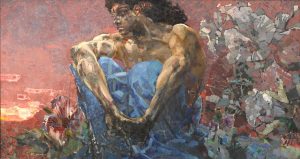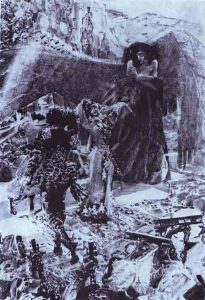Vrubel’s Thoughts
Throughout his early career, Vrubel developed the idea to paint The Demon Seated. He pondered over it for many years, intrigued by the archetypal fallen angel. However, many of those close to Vrubel attempted to dissuade him from painting this topic because they believed it would alienate the public and would be ill received by the Academy. This would lead to Vrubel destroying many drafts of the work along with many pieces from his time in Kiev. However, after moving to Moscow, he began to believe his work would continue to be incomprehensible to the public and embraced incomprehensibility.
Formal Analysis
The work depicts the figure of a demon, sitting atop a mountain, gazing out as the sun sets to the left. Flowers encroach around the demon, which stand nearly as tall as the figure and seemingly merging into the cloth that hands around the figure’s knees. The work is characterized by the persistent use of deep red in the background, blues for the clothing, olive for the skin, and sporadic use of red, grey, green, and purple in the flowers.
The brushstrokes are characterized by long, flat, suggestive strokes which would have been achieved through the use of a painting knife. This can be seen in the entire work, but most strikingly in the clouds, the sunset, on the figure’s clothing, and most prominently on the flowers to the right. Blending is visible throughout the work, but primarily in the background as a means to articulate the sky. There is also slight build up of paint throughout the work. These combined qualities endow the work with a sensation of evaporation, as if the figure is dissolving and becoming one with the background. This also adds a hallucinagenic property to the piece, which fits in with the habits of many Symbolists to use drugs in order to distort their worldly perception.
The flat brushstrokes also highlight the influence of Medieval church architecture, that which he was exposed to during his time in Kiev and Venice. This creates a crystal-like appearance which mimics stained glass panels and mosaics. The references to Christian architecture are significant because it not only points to Vrubel’s influences as well as a major stylistic point that would characterize much of his work, but it lends to a deeper understanding of the work. He is consciously integrating elements of Christian architecture in a work depicting a demon, which seems to suggest that even this image of a fallen angel could adorn the halls of a Medieval cathedral. This falls directly in line with the Symbolist approach, as this can be viewed as Vrubel integrating cunning messages which would have served to elevate the piece and illustrate higher truths which could only be expressed indirectly.
There is a high level of dynamism in the work. While the figure is seemingly in a passive pose, the flexing of their hands and the rigidness of the body suggest an active figure, who is not simply resting but perhaps waiting in anticipation of some unforeseen force. While there are active aspects of the work as seen in the body language, the figure ultimately appears stoic, sitting in solitude.
The composition of the work emphasizes the massive frame of the demon. Their body is not completely visible, with portions of the head being cut off at the top of the work and the demon’s feet seemingly stretching past the bottom. It creates almost a sense of claustrophobia in the work, as if the figure could break out of the piece at any moment.
In a 1890 letter to his sister Anna, Vrubel states:
“… I am painting the Demon, meaning not that fundamental “Demon” that I will create later, but a “demonic” – a half-naked, winged, young sadly thoughtful figure who sits embracing her knees against the sunset and looks at a flowering clearing with which branches stretching under the flowers that stretch to her.”
The use of “her” in this letter is significant, because the demon depicted by Vrubel was meant to bridge both male and female forms. The feminine aspects of the work are characterized by the figure’s long hair and the masculine illustrated by the demon’s muscular body. It illustrates a hybridization of gender that would appear in Vrubel’s other depictions of the “Demon.” This is also consistent with the approach of many Symbolists.
In discussing the work, Vrubel would describe the demon as:
“…a spirit uniting in itself masculine and feminine qualities…a spirit, not so much evil as suffering and sorrowing, but in all that a powerful spirit…a majestic spirit.”


 Tamara Dancing. Mikhail Vrubel. 1891. Tretyakov Gallery, Moscow.
Tamara Dancing. Mikhail Vrubel. 1891. Tretyakov Gallery, Moscow.